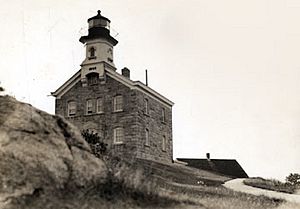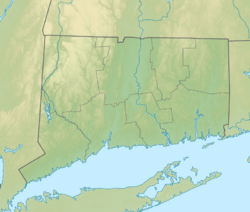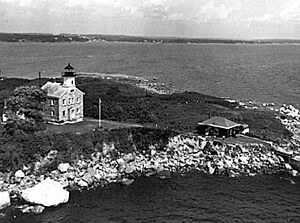Great Captain Island Light facts for kids
 |
|
| The light in 1935 (U.S. Coast Guard photo) | |
|
|
|
| Location | Greenwich Connecticut United States |
|---|---|
| Coordinates | 40°58′57″N 73°37′23″W / 40.982479°N 73.623006°W |
| Year first constructed | 1830 (first) 1868 (second) |
| Year first lit | 1970 (current) |
| Automated | 1970 |
| Deactivated | 1970-2011 (second) |
| Foundation | stone basement |
| Construction | granite and wooden tower (second) metal skeletal tower (current) |
| Tower shape | octagonal tower with balcony and lantern (second) square tower with light and daymark (current) |
| Height | 51 feet (16 m) (second) 62 feet (19 m) (current) |
| Focal height | 51 feet (16 m) (second) 62 feet (19 m) (current) |
| Original lens | Fourth order Fresnel lens (1858) |
| Current lens | FA-251 optic |
| Characteristic | Fl G 5s. (second) Fl WR 6s. (current) |
| Admiralty number | J0904 (current) |
| ARLHS number | USA-346 (second) |
| USCG number | 1-21401 (second) 1-21400 (current) |
The Great Captain Island Lighthouse is a historic lighthouse located on Great Captain Island. This island is found in the western part of Long Island Sound, just off the coast of Greenwich, Connecticut, in the United States.
The first lighthouse was built here in 1829. It was made of stone. However, it wasn't built very well, and its walls started to crack just ten years later. Because of this, a brand new lighthouse was finished in 1868. This second lighthouse was made of granite and had a light attached to its roof.
Over the years, the lighthouse added important features. A fog whistle was installed in 1890, and later a siren in 1905. The lighthouse stopped guiding ships in 1970 when a modern metal tower took its place.
In 1973, the Town of Greenwich took over the property. They had people living there to take care of it until 2003. By then, the old lighthouse was in poor condition. A big effort to fix it up was completed in 2009. A special light, not for navigation, was turned on in 2012. In 2010, a memorial plaque was placed there. It honors 23 people from Greenwich who were affected by the tragic events of September 11, 2001. The Great Captain Island Light was added to the National Register of Historic Places in 1991.
Contents
Building the First Lighthouse
In 1829, the United States government bought 3.5 acres of land. This land was on the southeast side of Great Captain Island. It was chosen as the perfect spot for a lighthouse.
The first lighthouse was completed in 1829. It was a stone tower about 30 feet (9 meters) tall. It also had a five-room house for the lighthouse keeper. Charles H. Smith built it for about $3,455.
By 1838, it was clear the lighthouse wasn't built well. The walls were cracking badly. Even so, it stayed in use until the newer tower was ready in 1868. The original light used 10 lamps with reflectors. In 1858, it was upgraded to a better Fresnel lens. This change made the light shine a steady white color.
The Second Lighthouse and Its Features
By 1867, officials decided a new lighthouse was definitely needed. The new structure was finished in 1868. This lighthouse was a keeper's house with the light attached to its roof.
It shares its design with other lighthouses. These include ones at Sheffield Island Light in Norwalk, Morgan Point Light in Noank, Old Field Point Light and Plum Island Light in New York, and Block Island North Light in Rhode Island. The main building is made of strong granite. The top part, where the light shines, is made of cast iron.
The original Fresnel lens from the first lighthouse was moved to the new tower. In 1890, a fog whistle was added. This was later replaced by a loud siren in 1905. The siren was so loud that it bothered people living nearby. Because of this, it had to be changed to be less noisy.
In 1970, a tall, freestanding metal tower replaced the light. The old lighthouse was then empty and sadly, it was vandalized. In 1973, the town of Greenwich took ownership of the lighthouse. Caretakers lived there full-time until 2003. They left because the old lighthouse had become too run down. In 1991, this historic lighthouse was added to the National Register of Historic Places.
Restoring the Lighthouse
In the late 1990s, a group called the Greenwich Chamber of Commerce began a project. They wanted to get the lighthouse shining again. The Indian Harbor Yacht Club helped them.
The project faced a sad moment when one of its first fundraisers, Bennett Fisher, passed away during the tragic events of September 11, 2001. In May 2007, the government approved $1 million for the restoration work. A non-profit group called Return the Light also formed in the 1990s. They raised $305,000 for the restoration. Most of this money was given in memory of Bennett Fisher.
In 2008, about $1.2 million was set aside for the restoration. The plans included a new light and fixing up the caretaker's living area. A special walkway, garden, and plaque were planned to honor those affected by the September 11, 2001 events.
Inside work on the lighthouse was scheduled from April to July. No outside work happened then. This was to avoid disturbing nesting herons and egrets. The whole project was set to finish in 2009. Some nature groups were worried about the birds. But Tom Baptist, who leads Audubon Connecticut, supported the work. He also made sure steps were taken to protect the birds.
In 2010, the September 11 memorial plaque was put in place. It honors 23 people from Greenwich who were connected to the town and affected by the events. On February 13, 2012, a special green light was installed. It flashes every 4 seconds. This light is not for navigation. It serves as a tribute to all lighthouses and their keepers who worked to keep people safe on the Sound.
Visiting the Lighthouse
A single dirt road leads to the lighthouse. It is on the eastern side of the island. This area is also where many egrets like to build their nests. The Greenwich Department of Parks and Recreation manages the island.
Currently, there are no public tours of the lighthouse or the island. However, caretakers still live at the lighthouse.
Lighthouse Keepers
This list shows some of the known keepers of the Great Captain Island Lighthouse. It does not include assistants or Coast Guard officers.
| Name | Year | Reference | Service Notes |
|---|---|---|---|
| John W. Smith | 1830–1834 | ||
| James Merritt | 1834–unknown | ||
| James Bride | 1839–1848 | ||
| Benjamin Merritt | 1848–1849 | ||
| George W. Anderson | 1849–unknown | ||
| Charles McIntosh | Unknown | ||
| Alexander Worden | 1856–1858 | ||
| Gilbert Horton | 1858–1861 | ||
| James Merritt | 1861–1863 | ||
| James Travis | 1863–1864 | Full name unknown | |
| George Lusk | 1864 | ||
| James McCulloch | 1864–1871 | ||
| Eliakim F. Worden | 1871–1890 | ||
| Eugene Mulligan | 1890–c. 1907 | ||
| John Nelson | 1916 | ||
| Adam L. Kohlman | late 1920s – circa 1944 | ||
| Laureat LeClerc | Circa 1930s | ||
| Frank B. Abel | 1969 | Coast Guard Officer in Charge |



